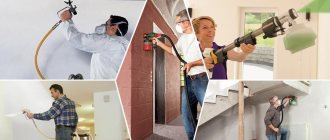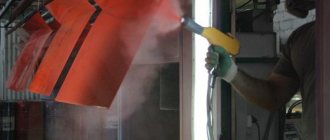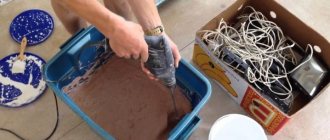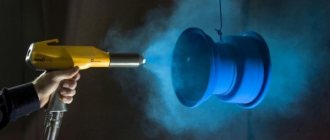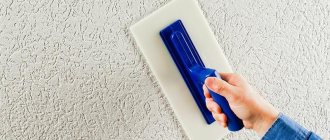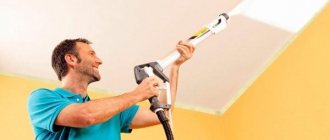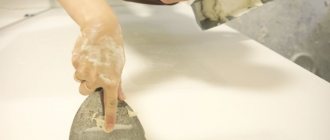Cleaning the spray gun after painting
Hello dear readers of the kuzov.info blog!
Let's consider such an important procedure as cleaning the spray gun.
Wash the spray gun immediately after use
Most often, two-component products are used in body repair. Primer, paint or varnish mixed with a hardener have a limited “lifetime”. Do not leave the product with the hardener in the spray gun for a long time. Immediately after use, the spray gun must be washed.
A poorly cleaned gun can cause a lot of problems.
To clean the spray gun you will need:
- Solvent (you can use 647, for example) or water, in the case of water-soluble paint.
- Container made of solvent-resistant material. You can prepare a small container for soaking some parts of the spray gun.
- A lint-free cloth.
- Special brushes for cleaning spray guns and toothpicks.
- A suitable size wrench for unscrewing the spray head and nozzle. This key is usually supplied with the spray gun.
- Solvent resistant protective gloves.
How to clean a spray gun?
- Drain any remaining paint from the spray gun tank. Unscrewing the paint head
- Use a lint-free rag soaked in solvents to clean any remaining paint from the inside of the spray bottle.
- Remove the strainer from the base of the reservoir opening (for spray guns that have one).
- Pour solvent into the reservoir, filling it about halfway. Close the lid and shake the spray gun so that the solvent in the tank acts on any remaining paint.
- Connect the spray gun to the air hose (if it is not connected) and spray the solvent that was poured into the tank. You can spray it on a rag to prevent the room from becoming filled with sprayed solvent.
It is not necessary to spray all the solvent; you can spray until clear solvent is blown out. This will help clear the channels that carry paint as you spray.If you are using a gun with an overhead paint tank, you can do the same cleaning procedures without an air hose attached. You can turn the paint supply control to maximum, pull the trigger and the solvent will flow through the nozzle, cleaning the paint channels.
Cleaning the paint channel
- Pour out any remaining solvent from the reservoir.
- Wipe with a clean, lint-free cloth inside and outside the spray gun tank. Don't forget about the tank cap.
- You can remove the spray gun tank and clean the channel through which paint flows from the tank to the spray gun.
If you clean fresh paint on time, this item is not necessary. - Unscrew and remove the air cap of the sprayer along with the seal.
- Unscrew the paint supply regulator and remove the needle and spring.
- Using a suitable wrench, unscrew the spray head and nozzle.
- Place the needle, paint head and air cap in a small container of solvent. Remember that you can soak some parts of the spray gun in solvent, but not the entire spray gun.
- After soaking the above-mentioned parts of the spray gun in solvent, use a special brush to clean them.
- Use a special small brush and solvent to clean the paint channels.
- Check the holes in the air cap. If they become clogged, you can use a toothpick.
- Wipe the needle thoroughly with a rag.
Attention: when cleaning the spray gun, do not use metal brushes or abrasive materials.
Reassembly must be done in reverse order. When assembling, you can lubricate the needle with a special lubricant. It is necessary that the lubricant does not get on the sharp part of the needle, as it comes into contact with the paint.
Adviсe:
- Use solvent-resistant protective gloves to protect your hands.
- You need to be careful with the needle, as it can be easily bent. A barely noticeable bend is enough and it will have to be changed along with the painting head.
- After rinsing all parts with a clean solvent, you can blow everything off with compressed air or wipe it with a dry cloth.
Print article
How to clean a spray gun
A prerequisite when using a spray gun is to wash it after each use. First comes the preparatory part (preparing materials, draining the remaining paint), then the main part of the procedure, which includes several stages - disassembly, cleaning, drying, assembly.
Disassemble the spray gun
Before you begin disassembling the tool, you need to drain the remaining paint from the tank. Some recommend first pouring solvent into a paint container and driving the solution, and only then removing the parts and washing them. In this case, you should draw the solution into the tank and connect it to the air hose. You need to blow until clean liquid comes out without paint residue. To prevent the room from becoming filled with solvent, it is recommended to spray it into a rag or carry out the procedure outside. You can try another option - first disassemble it, then soak the parts and wash the gun.
Step-by-step instructions for disassembling the spray gun:
- The first thing to start with is to unscrew the tank and put it in a container or sink.
- The next step is to remove the air cap and place it in a container as well.
- Next you need to remove the nozzle, but before that you need to press the start button all the way. This action is performed in order to move the thin needle away from the nozzle.
- After the user has removed the tank and nozzle, an air distribution ring appears. This element does not need to be washed because it does not interact with materials. The exception is when dirty solvent or paint comes in during disassembly.
- The last disassembly step is to remove the needle. To do this, press the key all the way. At the same time, the needle is fed back, then pulled out of the spray gun body.
- Be sure to check the holes in the air cap. If clogged, you can use a toothpick.
- Now the gun design is completely prepared for washing - all air and material channels are accessible, they can be easily cleaned with a brush.
When disassembling, you need to take out the needle especially carefully. It bends quite easily, and if possible damage requires replacement along with the painting head.
Clean and dry
After the parts are disassembled, they must be washed under running water. In case of severe contamination, they can be soaked in a prepared container. To clean the tank, you need to pour ½ of the volume of solvent. Afterwards, shake thoroughly so that the remaining paint is completely dissolved, and drain the solution. The gun body is washed with water and cleaned with a brush.
The air distribution ring has a seal, which begins to swell upon prolonged contact with water. Then it is difficult to insert this part into the spray gun. Therefore, the air distribution ring does not become wet. It is cleaned with a brush-brush.
The next step after washing is blowing with compressed air. The procedure is needed to eliminate residual dirty solvent. After this step, you need to wipe all parts and the needle with a rag, inside and out. Now the pistol design and its parts are ready for assembly.
Assemble the spray gun
The final stage of the procedure is assembling the spray gun. The user must adhere to a clear sequence:
- Insert the needle and carefully tighten it.
- Then insert the air distribution ring with the seal. There are special guides on the part and the body of the structure that allow you to connect the parts in the correct position.
- Tighten the nozzle by pressing the trigger all the way and holding it until the last turn. Then tighten it with a wrench.
- Screw in the air cap and adjust.
- The final step is to put on the tank.
During assembly, a special lubricant can be applied to the needle. You just need to do this carefully so that the composition does not get on the sharp part of the needle. Also, when washing, moving elements that do not come into contact with the paint must be periodically lubricated.
The spray gun is a special painting technology device that ensures uniform application of the composition. In order to obtain a high-quality paint coating in the future, it is necessary to properly wash the tool. To do this, it is important to carry out the procedure at all three stages - disassembling, cleaning and drying, assembling the paint sprayer.
Cleaning and washing the spray gun
It would seem that the topic does not deserve special attention, but it also has its own nuances. There comes a time when you need to paint and for some reason the spray gun works a little worse than usual. You can’t get a good, high-quality torch on which the painting result depends. A bad torch is the unevenness of the layer and hence the lack of painting or unintended smudges. The spray gun works worse or particles of the previous paint fly out of it (a very extreme case of unclean spray gun). Sometimes the problem is that they took the time and solvent to properly clean the spray gun after the previous painting. Everyone (over time) comes to the conclusion that painting still requires at least two spray guns - one for primer and the second for final painting. The second one must always be absolutely clean. Sometimes a brush is included with the spray gun for cleaning it, but you can do without it. There are simple and affordable things. This is a way to “self-clean the spray gun”, a nozzle cleaner instead of a “brush” and a simple soft brush that will clean the tank of fresh paint deposits. And there are solvents that are more or less suitable for cleaning a spray gun. To wash the spray gun I use strong acrylic solvents. Previously I tried to save money on 646, 650th solvent, but it cleans worse. How to wash my spray gun, and this is the normal option - I blow out all the paint along with the air, and when there is a lot of it, then it is better to pour it out of the spray gun. If the glass on top is clean, then I try not to dirty it. It is necessary that the paint comes out through the nozzle and the trigger is pressed. But paint often doesn’t work that way, then it’s not a very aesthetic method (but sometimes you still feel sorry for acrylic solvent, then this method will do). If you blow through the top hole in the tank, the paint will come out of the spray gun. If the tank is already dirty around the edges and top, then you still have to wash it completely and then you can pour the paint “over the side.” Just like everyone else does. — What remains is the dirty tank and the insides of the spray gun, without unscrewing the tank, I pour a little acrylic solvent into it (or P-12 solvent, if I’m not mistaken, I’m not used to it yet) and immediately take a flat small brush (it’s only for this purpose). I wash all the walls of the tank for the first time, the brush cleans everything perfectly. The solvent is already dirty, I release it along with the air through the spray gun. — I pour clean solvent into the tank again. Just a little each time. Again I quickly rinse the glass with a brush, now both outside and inside. The outer part is already clean; it can be wiped with a rag. Now I wash it with a brush and close all the holes in the air cap alternately with my fingers and press the trigger, the pressure is connected. There is a “bubbling in the glass” effect. The solvent from the channels rises in a stream upward into the tank and all remaining paint also rises. This is how we clean the insides ourselves. If we see “some pieces”, then it is better to pour them over the edge; if it is just a dirty solvent without debris, then again we release it along with the air through the spray gun. - Further on the situation. I usually disassemble the spray gun, but not necessarily the whole thing. If I paint it after a month, then I take it all apart and even take out the needle. If you paint the next day, then I don’t have to unscrew the needle, easily wipe everything with a rag (the tip of the needle is required), screw on the glass, put the spray gun back together and pour a little solvent into it. If the model allows it (there are no gaskets in the air cap or they are not afraid of long-lasting solvent), then I leave the air cap in the tank with the solvent. It seems like this was done before, but now (2015-2016) we need to be more careful. There are spray guns that are not designed for prolonged soaking in solvent. There is a regular brush, they wash it with a brush AND THAT'S ALL.
The video about cleaning the spray gun may not be very detailed, but it will be more detailed in the test. Let's take care of our spray guns!
1 comment Cleaning and washing the spray gun
Cleaning and washing the spray gun must be taken very seriously. Since if this procedure is not carried out efficiently, the spray gun may become unusable.
Complete disassembly and thorough cleaning of the spray gun
Cleaning the spray gun without completely disassembling it can be done no more than 3 times. If this is done constantly, then such a device performs rough work. When the time comes for final painting without completely disassembling it and thoroughly cleaning it, problems may arise. If the primer or varnish is not washed out in a timely manner, they will clog the spray gun channels.
There is no need to talk about high-quality paint spraying. In this case, under the influence of the solvent, particles of dried old paint flake off during painting and fall onto the new layer of the painted surface. These pieces of debris need to be removed. Often the surface has to be repainted again. This will lead to overuse of paintwork materials and loss of time.
Before washing the spray gun thoroughly after painting, you need to disassemble it thoroughly, performing the following operations:
- The unscrewed tank is placed in the sink.
- Unscrew the air cap and remove it. Actions are easy to perform.
- When the trigger is pressed all the way, the nozzle is removed. If the trigger is not pulled, the needle will not move away from the nozzle, and it will be damaged when unscrewing.
- A dirty air distribution ring can be cleaned with a brush. It is strictly forbidden to soak it. Otherwise, the adjacent seal ring will swell when soaked. In this form, it will no longer be possible to put the air distribution ring back in its original place.
- When the trigger is pulled again, the needle moves back and is pulled out of the sprayer body.
- All channels in the device became open. To clean them, the spray gun kit from the manufacturer includes a special brush.
- To ensure that no dirty solvent remains inside the gun, it is blown out with compressed air. Dirt particles will dry inside the spray bottle if these steps are not taken.
Interesting video on the topic:
When the purging is done, the steps for assembling the spray gun are performed in the reverse order:
- The needle is inserted and fixed.
- The distributor ring is put on and fixed.
- By pressing the trigger all the way, the nozzle is screwed on.
- The nozzle is fixed with a key.
- The air cap is put on and adjusted.
- The tank is screwed on.
Disassembling, cleaning and assembling the spray gun is not difficult. This does not take much time, but guarantees the quality of the coloring.
Any new model of spray gun must be washed with a solvent, since it goes on sale lubricated with transport oil or a special lubricant. The pistol is completely disassembled beforehand. You only need one key to operate.
We recommend videos on the topic:
Disassembling a Chinese gun for cleaning
In the work you will need a set of keys, and you need to add a 9 mm socket.
Disassembly is performed sequentially:
- The tank unwinds.
- The needle is pulled out from behind through the hole that appears after unscrewing the adjusting screw.
- The air cap is dismantled.
- The key for unscrewing the injector is selected. The key from the set unscrews the nozzle.
- The next step requires caution in your actions, since the platform has a left-hand thread. In this case, the distributor ring is tightly twisted. You will need a hex wrench and a 9mm socket wrench. They dismantle the ring with the gasket.
The sprayer is assembled in reverse order. It is important to mount the ring gaskets as bridges over the air holes. Air entering the chamber will create turbulence. Parts that come into contact with each other are treated without silicone lubricant.
Main advantages
The compressor, together with an air sprayer for an aquarium, performs a number of functions that no other type of equipment can cope with:
- saturation of water with oxygen;
- equalization of temperature by mixing layers of water;
- prevention of water stagnation and poisoning of aquatic organisms by accumulated waste products;
- creating a current necessary for some species of aquarium inhabitants;
- reduction of point water pressure on hydrobionts;
- giving a decorative appearance to an artificial reservoir.
Basic techniques for painting simple surfaces
Working with a spray gun requires not only the ability to hold the tool in your hand and make smooth movements, but also to use various techniques for painting individual surfaces and geometric bodies.
The basic rule for working with a spray gun is the rule of correctly holding the tool in your hand. For professional spray guns when working with nitro enamels and alkyd paints, it is generally accepted that the optimal distance from the tool nozzle to the surface to be painted is 20-25 cm. For medium and low pressure spray guns, the distance can be 15-20 cm. This distance to the surface makes it possible to obtain an optimal paint spot , which accounts for 80% of the paint sprayed.
The second rule for the correct use of a spray gun when painting is the rule to hold the spray gun at a right angle to the surface that is being painted. Changing the angle to the side produces a spot on the surface in which only 50-70% of the paint occupies the main part, thus, when changing the angle, up to 50% of the paint can be lost, which ultimately leads to poor quality of painting.
Painting flat surfaces is usually done in a vertical position or with the workpiece at the bottom, with the exception of ceiling surfaces. In the room where painting is carried out, drafts, side or ceiling air exhaust are not allowed, all this can lead to a deterioration in the quality of painting, and when painting in natural conditions outside, windless weather is usually chosen.
The main painting techniques are works associated with painting individual surfaces that have simple geometric shapes. Thus, the complex surfaces of pillars, gratings, columns are divided into separate segments and painted gradually, applying paint in 2-3 layers. The easiest way to paint a flat surface mounted vertically. Here the technique of passing the spray gun 3 times with 1/3 overlap is used.
The spray gun is turned on outside the surface approximately 10-15 cm, then the spray gun moves from left to right across the painting area. During the first pass, approximately 1/3 of the torch should lie on top of the surface to be painted. The spray gun is turned off when it goes beyond the workpiece. The next layer is applied by covering 2/3 of the paint strip downwards, so in the first pass a strip of no more than 10 cm is painted, the air supply is turned on and off in the same way - outside the surface. The third stripe is carried out with an overlap of 2/3 of the second stripe. The direction of movement of the painting line is taken from top to bottom. The main thing in this technique is to hold the instrument correctly and move it smoothly and avoid stopping.
The main mistakes when working on a flat surface are:
- Stopping the spray gun in one place when paint drips form;
- Moving too quickly, when the paint leaves behind gaps and unpainted areas;
- Changing the angle of the spray gun, resulting in the formation of unevenly colored areas;
- Turning the tool on and off above the surface to be painted.
Device malfunctions
Often the spray gun has to be disassembled not in order to clean it after use, but for the reason that certain disturbances occur in its operation. Possible defects in the operation of the gun and ways to eliminate them:
- Sometimes the spray gun is deformed on one side, too small or curved. In this case, you need to inspect the nozzle and make sure that the nozzle is not damaged. If necessary, replace the nozzle and thoroughly clean the air cap.
- Sometimes the torch vibrates and air bubbles appear in the water. In this case, you need to tighten the nozzle; if this does not help, replace the distribution ring.
- It happens that the adjusting head scrolls or does not work at all. In this situation, you should lubricate the thread by first unscrewing the head completely, or replace the distribution ring.
- Air may begin to siphon. If this happens constantly, then you need to clean the air piston seat or replace the piston itself.
- If corrosion is detected on the gun body, air cap threads or in the material supply channel, carefully rinse the spray gun, and then be sure to blow air inside and outside all parts of the tool.
All work must be carried out in the order described in the instructions for the device in order to prevent deformation of parts and failure of the device.
There are no similar entries.
Click " Like
» and get the best posts on Facebook!
Spray guns of any type, whether electric, pneumatic or mechanical, will serve for a long time if, after working with them, the main parts of the tool are properly washed. In the article we will share our experience on how to clean the spray gun quickly and, most importantly, correctly. First of all, you need to decide which parts of the structure need to be washed.
After painting, the spray gun must be washed
As you might guess, these places will be those parts through which the paint and varnish material passes: paint, solvent and varnish. This, of course, is a container for the material, a paint supply channel, a nozzle of the painting head, the head itself and a dosing needle.
After finishing the painting work, it is necessary to drain the remaining material from the tank and pour in about 100 g of solvent: 646, solvent, acetone. If a solvent is not at hand, washing with A95 gasoline is an option, but this is a temporary effect, since solvents still need to be used after it.
Step-by-step cleaning of the spray gun
After pouring the solvent, you need to pull the trigger of the spray gun and wash through the parts that were working in the paint for a few seconds. Then close the nozzle with your finger or a rag and press the trigger again for a while. As a result, all the remaining paint will return to the tank, from which it must be drained. Repeat the entire washing procedure again, but with a clean solvent.
Make sure that the metal parts of the brush do not damage the nozzle. The best option is to use specially designed SATA cleaning brushes
We unscrew the nozzle head and mechanically clean the two pairs of holes in the upper part of the head. For this, it is best to use thin objects made of soft material: wood, plastic, but if this is not available, the use of aluminum wire is allowed as a one-time exception. It is best to use special brushes and brushes that are included with the tool when sold. After cleaning the holes, the head is washed manually in a clean solvent, wiped with a dry and clean rag and screwed back in. That's it now.
Practical advice:
The long life of any device depends on following the instructions for its use and care.
It is important to note that cleaning a spray gun is not a difficult task at all, but it must be done regularly. Otherwise, the paint will dry out and it will be impossible to wash the spray gun.
Paint application tools are no exception.
Work execution algorithm
The parts through which the paintwork moves are washed:
- dye tank;
- material supply channel;
- nozzle;
- painting head;
- needle-dosage.
First stage
When painting is completed, the remaining paint is drained from the tank before cleaning the spray gun.
- 100 grams of solvent is poured into the container . Use grade 646, solvent or acetone. You can replace the solvent with A95 gasoline. But this is in case there was no solvent on hand at the time of processing. Because after gasoline, the container is still washed with solvent.
- The trigger of the spray gun is pressed. At this point, the solvent from the tank passes through the parts that were the paint conductor and washes them. The procedure takes a few seconds.
- The nozzle is closed with your finger. The trigger is pulled again. The remaining dye is washed into the tank and merged with the solvent.
- The steps are repeated with a new clean solvent.
Useful video on the topic:
Second phase
Don’t forget to clean the channels in the nozzle head. This is where the flame forms.
- The nozzle head is removed.
- In the upper part of the head, 4 holes are cleaned. Soft materials are used (wood, plastic, aluminum wire is allowed). The holes are small, so they can be cleaned with thin objects. But most often, brushes or brushes from the spray gun kit from the manufacturer are used.
- When the holes of the head are cleaned, it itself is washed with freshly poured clean solvent.
Finished washing the spray gun after painting.
Immediately after cleaning, it is not recommended to force the tank onto the mounting thread. It may happen that after the parts dry, paint particles stick to the thread. And before cleaning the spray gun next time, it will be difficult to unscrew this thread.
Torch print with a lot of paint on the left or right side (crescent torch)
- The cause may be partially clogged (on one side) air holes on the protrusions of the air cap. There is a blockage on one side of the paint head.
- To determine more specifically where the clog is located, rotate the air cap 180 degrees and do a test spray. If the torch imprint has not changed, then the blockage is in the paint head. If the pattern of the torch has changed, then the problem is in the air cap.
- The air cap lug holes on one side are clogged or the front air holes are clogged. The problem is solved by cleaning.
Whitewashing with a spray gun
Mixing the solution
Prepare the solution according to the instructions on the package. As with paint, the formation of lumps is unacceptable, so the liquid must be mixed thoroughly. If the volume is large, then it is convenient to do this using a drill with a mixer attachment.
Checking the equipment settings and the dyeing process looks the same as when dyeing. After applying the first layer, which should be quite dense, change the settings of the device so that the lime “fog” becomes less thick. The second layer will be thinner: this way the whitewash will last longer, and all the imperfections of the first layer will be masked.
Upon completion of work, the spray gun must be cleaned of any remaining paint or whitewash. Take out the tank and pour out the rest of the coloring composition from it, after which you need to pour in the solvent (for whitening water-based paints - water) and spray it with a sprayer. This procedure will help clean all parts of the device.
Particular attention should be paid to cleaning the spray nozzle, which must be treated with a sponge and solvent.
As you can see, working with a spray gun is not difficult. With a little practice, you will understand how this is done and will be able to paint any surface.
When planning a repair, many people study in advance how to use a spray gun correctly. Such a responsible approach can only be welcomed, since these devices are quite complex, and working with them requires certain skills.
However, after fundamental theoretical training it will be much easier to master the painting technique, so we strongly recommend that you carefully study this article.
Advice from professionals
In order for the equipment to function for a long time and work without failures, it is recommended:
- Wash the spray gun very thoroughly after each use with a solvent specially designed for this purpose.
- Clean the equipment only with a soft brush or toothpick, avoiding hard metal devices that can damage the air cap.
- It is recommended to regularly lubricate all moving parts of equipment that are not in direct contact with paint and varnish with a special silicone-free lubricant.
- At least once a week you need to disassemble the sprayer to completely and thoroughly clean it.
- At least once a year, worn parts of the gun should be replaced with new ones, using special sets of spare parts produced by manufacturers.
Preparing for work
Device assembly
So, we have a spray gun, we also purchased it, it’s time to start finishing.
You need to start working by assembling the device:
As a rule, household models are not distinguished by their design complexity. To bring them into working position, simply select the appropriate nozzle with a needle from the set and install it in the mount.
Pneumatic models are somewhat more difficult to assemble. In addition to installing the nozzle, we attach a hose for supplying compressed air to the handle. The container at this stage needs to be connected only if it is located on top. We connect the lower tank to the paint supply system after filling. When all the parts are assembled, you can perform an idle start of the device (with water poured into the container)
In this case, we pay the closest attention to the place where the hose and nozzle are attached: there should be no air leaks!
Dilution of paint
To work effectively, you need to know how to prepare paint for a spray gun. This is due to the fact that small diameter nozzles work well only with material of a certain viscosity, and this viscosity will be lower than that of paint from a can.
That is why the pigment must be diluted.
- The easiest way to dilute is to use special containers that come with the device. Typically, the instructions for the sprayer contain recommendations on the proportions of mixing pigment and solvent for certain tasks.
- If there is no such capacity, then our task becomes more complicated. However, you won’t have to bother with water-dispersed compositions even in this case. The thing is that the permissible maximum for these pigments is 10% water (by weight), so it will be difficult to miss.
But we’ll tell you below how to dilute paint for a spray gun when working with a solvent:
First, pour a small amount of pure pigment into a container and spray it onto the surface.
We evaluate the result.
If the pigment falls on the base in large drops or does not splash at all, add about 5% of the appropriate solvent to the paint and mix thoroughly.
- We perform a test painting again, control the quality of the surface and add solvent. So we can experimentally establish the optimal proportion for any composition in just a few minutes.
- Ideally, we need to achieve a consistency such that, on the one hand, a fine mist will fly out of the nozzle, and on the other hand, a solid film of sufficient thickness will form on the surface to be painted.
Settings
The last point that we need to complete before starting the work itself is setting up the device. You can figure out how to adjust the spray gun by eye, but we will still give some tips here.
Household models, especially those in the budget segment, usually have a limited number of adjustable parameters. But the operation of high-quality professional and semi-professional devices can be customized to solve a specific problem.
Typically the following parameters can be adjusted:
- Flare configuration.
- System pressure.
- Paint supply.
Below we will look at what they affect and what values should be set in certain situations:
In most cases, adjusting the torch is carried out intuitively, and after several tests it allows you to select the optimal configuration of the pigment flow. The maximum width is chosen when we need to process a large area (this way we can ensure uniform coloring and save time), and the minimum width is chosen for fine finishing and artistic painting.
- The pressure must be adjusted for each spray gun model and each type of paint separately. To select the optimal size, it is enough to make one “spray” on a clean, flat surface. If large drops appear, add pressure; if the spot is not round, but has the shape of a figure eight, then reduce it accordingly.
- By the way, you can control the pressure in two ways: either using the regulator on the pump receiver, or using a screw on the spray gun itself. The first method allows for coarse adjustments, the second for finer adjustments.
- As for adjusting the flow of paint into the nozzle, craftsmen usually set this value to the maximum. The flow is adjusted directly during operation, by dosing the pressing force on the spray lever.
If after reading these tips you feel a little confused, don’t worry. In fact, setting up the spray gun before work is very simple, and in most cases takes no longer than a few minutes. It’s like riding a bicycle: it’s enough to understand the principle once, and in the future all operations will be performed “automatically.”
Cleaning the device: features of the procedure
In order to clean the spray gun you will need a spray gun cleaning kit.
If heavily soiled, use a brush. Wipe the body with solvent to remove paint. After this, blow the housing and channels with compressed air, or dry with paper towels. Carefully inspect the trigger; if paint or dirt remains under it, it will begin to stick, which will lead to interruptions in the operation of the device. The injectors and nozzles are not suitable for cleaning. They are cleaned using brushes, and especially small holes with special needles or toothpicks. After washing, all parts are dried. Then the spray gun is assembled. To clean the airbrush, it is advisable to use a special kit (sold in stores) so as not to damage small parts of the device.
During assembly, all rubbing parts are treated with silicone-free lubricant. It is recommended not to screw the head on, but to store it in a tank in a small amount of solvent.
If you plan to work with short breaks, and quickly drying paint and varnish material is poured, then prepare a container with solvent into which you can lower the head during the break. The main thing is not to wet the seals. This procedure will prevent the paintwork from drying out in the nozzle and subsequent disassembly of the spray gun.
On a production scale, it is difficult to wash all spray guns manually. For this purpose, a special washing machine is purchased, consisting of a pump and a washing chamber.
Difficulty level: Easy
1 step
When finished painting, drain the remaining paint from the tank. Pour solvent into it (if painting was done with water-based paint, use water instead of solvent), wash the tank of paint residues and drain the solvent. Then pour the solvent into the tank again and point the spray gun into the container to paint. In this way, the internal channels of the paint sprayer are washed out. Then unscrew the tank, wash it completely and partially disassemble the spray gun in the following sequence:
Step 2
Step 3
Step 4
Step 5
Washing the spray gun
Remove paint and rinse the channels in the spray gun body and all its parts. Use special pipe cleaners, brushes, punches and wipes for this purpose.
Particular attention must be paid to the holes in the air cap (5), they must be thoroughly cleaned without being damaged (use special skewers made of soft metal or regular toothpicks). The further quality of painting will depend on this. To wash the spray gun, use appropriate solvents for the paints used.
Step 6
The procedure for assembling the paint sprayer
After washing, reassemble the spray gun in the reverse order. When storing the spray gun for a long time, it is recommended to lubricate the parts in contact with each other with oil that does not contain acids and alkalis. This will prevent them from sticking and ensure trouble-free operation.
Step 7
Be careful when disassembling and assembling the spray gun to prevent deformation of the needle or nozzle tip. Observe the following rule: – remove the needle before unscrewing the nozzle; – install the needle after screwing the nozzle
A SATA paint sprayer was taken as a sample. The principle of washing paint sprayers is not much different. The devices of some other models of paint sprayers can be viewed in the pneumatic tools section on the website: https://basan.com.ua/
After each painting, the painter must clean his equipment, and for this he needs to know how to disassemble the spray gun in order to properly rinse and clean it. After all, if you miss the moment and allow the old paint to dry, it will be quite difficult to clean the sprayer.
But this is not the most unpleasant thing. The worst thing is that the spray gun may fail altogether, or work with new materials may be spoiled by old paint that peeled off during work and got onto the surface being treated. This can significantly spoil the appearance of the surface.
The nozzle and air cap for the spray gun should be washed especially carefully, carefully and carefully, and it should be remembered that in no case should they be cleaned with wire or other hard objects, as this can damage the device. You should only use soft brushes or toothpicks. To disassemble paint sprayers, you will need keys, and the number of them may vary for each model. And to clean, you will need a brush, which is included with the spray gun when sold.
Quality materials to get the job done
- solvent;
- special key;
- brush;
- special needles or toothpicks;
- special washing machine;
- quick-drying paint and varnish material.
To keep the sprayer in working condition, washing with water is clearly not enough. For these purposes, a special solvent is used.
Experts recommend disassembling the spray gun to thoroughly wash all parts at least once a week. The nozzle and air cap require careful cleaning. Under no circumstances should you use wire or other hard objects to wash them. Soft brushes or toothpicks are more suitable here. It is recommended to periodically lubricate moving parts that do not come into contact with the paint and varnish substance. With frequent use of the spray gun, they wear out and require replacement. For this purpose, there are special kits on sale that allow you to carry out independent maintenance of the sprayer. No additional skills are required to clean the device. It is enough to wash the spray gun after each use. If this is not done, then in addition to failure of the device, there may be other disastrous consequences. For example, under the influence of new paints and varnishes, the hardened layer of old paint inside the spray gun peels off and, together with the jet, falls on the product being painted. The maximum effect of washing is achieved by disassembling the spray gun and cleaning each of its parts.
Disassembly is carried out as follows:
- disconnect the paint feed regulator, remove the needle;
- Use a special key to unscrew the spray gun head and its nozzle.
